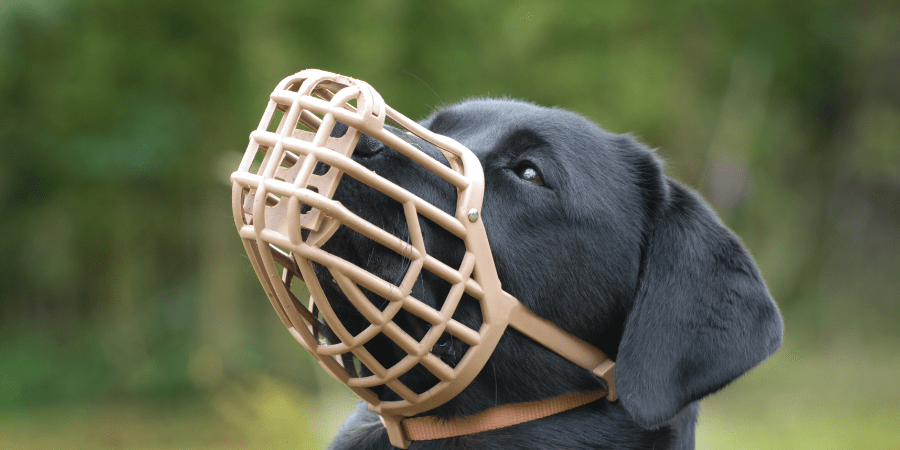Many misconceptions about muzzles have been brought to light since it’s become a legal requirement for many dogs to wear muzzles following the XL Bully ban in England, Wales and Scotland.
Some people think that muzzles are bad for dogs. They think of them as prisons for pooches, and think they look barbaric and cruel. When in fact, dogs don’t care what they look like – that’s a human thing. Dogs only care about having a comfortable muzzle that fits them properly.
Thinking a dog that is wearing a muzzle must be ‘dangerous’ isn’t accurate either, as muzzles have many other uses. For example, they can offer safety for dogs themselves, especially for curious canines that like to eat dangerous non-food items when out on walks or in the garden.
This is why we’re keen to de-bunk myths about muzzles in this blog.

1. Myth: ‘Muzzles are prisons for dogs’
Truth:
Muzzles are not designed to be ‘prisons’ for dogs and shouldn’t restrict your dog’s ability to drink water, pant freely and take treats. That’s why you should research different dog muzzles first and make sure that you buy the right one for your pooch.
A dog muzzle should be comfortable, well-fitting and offer plenty of room for your dog. You should also make sure that it doesn’t irritate your dog’s skin and allows excellent airflow, so they don’t overheat while wearing it. When wearing a muzzle, your dog should be confident and happy – not feeling like they are being punished. Read more about finding the right muzzle for your dog here.
2. Myth: ‘Muzzles look barbaric’
Truth:
We guarantee you that your dog doesn’t care what their muzzle looks like – they only care that their muzzle is comfortable. It’s just us humans that care about the appearance.
But there are all sorts of types, styles and bright colours out there to suit your pet’s personality. You could even match up the muzzle with your dog’s collar and lead. Just make sure that the muzzle you choose is big enough to allow your dog to open their mouth fully, has excellent airflow and the gaps are wide enough for treats (for positive reward-based training) to be passed through. Check out our vet approved muzzles here.
3. Myth: ‘Dogs that wear muzzles are dangerous’
Truth:
Not all dogs that wear muzzles are dangerous. However, we do recommend that you ask the owner first before approaching any dog – regardless of whether they are wearing a muzzle or not. We do understand how muzzles can create the fear of the unknown, especially if you’ve only seen them portrayed on fierce-looking guard dogs in films.
But it’s important to be aware that muzzles can be used for other positive reasons. In fact, most of the dogs in muzzles you see out and about are not to be feared as muzzles are a great way to protect our furry friends. Most dogs are curious and love to sniff out things during walks – but a muzzle can help to stop them from picking up potentially harmful foods or substances.
Even the friendliest of dogs can find some situations stressful, such as visits to the groomers or the vets. Especially if your furry friend is in pain or has had an uncomfortable experience in the past. That’s why we recommend that all owners should include muzzle training in their general dog training so if your dog does ever need to wear a muzzle, it’s not a scary experience for them. Read more about muzzle training here.
4. Myth: ‘Muzzles are promoting animal cruelty’
Truth:
It’s important to understand that a muzzle is not ‘animal cruelty’ – provided that your dog is wearing a suitable one, that you’ve spent time getting them used to it, and that you don’t force them to wear it all the time. Muzzles have their uses for walks or when your dog is in a public setting, but they shouldn’t be worn constantly.
It's always key for pet owners to slowly introduce a muzzle in a positive way, to help their dog become confident and happy wearing it. Muzzle training should be done at your dog’s pace and shouldn’t be rushed.
The most important thing is to have patience and give your dog time to adjust and feel comfortable wearing a muzzle. For more on how to muzzle train your dog, watch our helpful video below:
5. Myth: ‘Dogs can’t see anything with muzzles on’
Truth:
A suitable muzzle shouldn’t restrict your dog’s line of sight. That’s why it’s so important to research different muzzles beforehand and measure your dog’s nose – to make sure it’s the right fit.
It can be very tricky to find a muzzle that fits a flat-faced breed, such as Pugs, Pekingese and French Bulldogs, as they often struggle with their breathing and have different shaped faces compared to other breeds. If you are struggling to find a suitable muzzle for your dog, speak to your vet for advice.
For more advice on dog muzzles, read our Pet Health Hub guide here.
